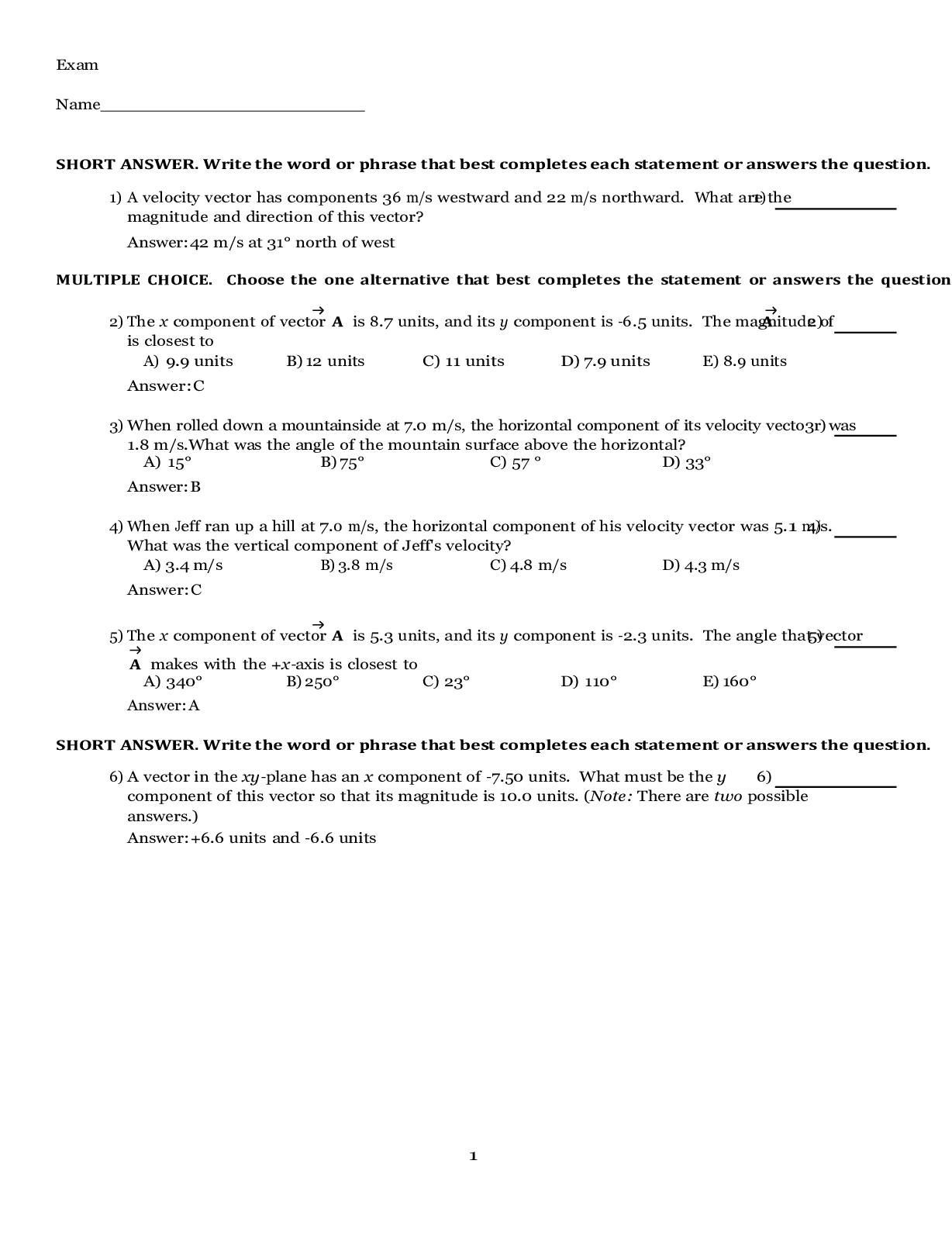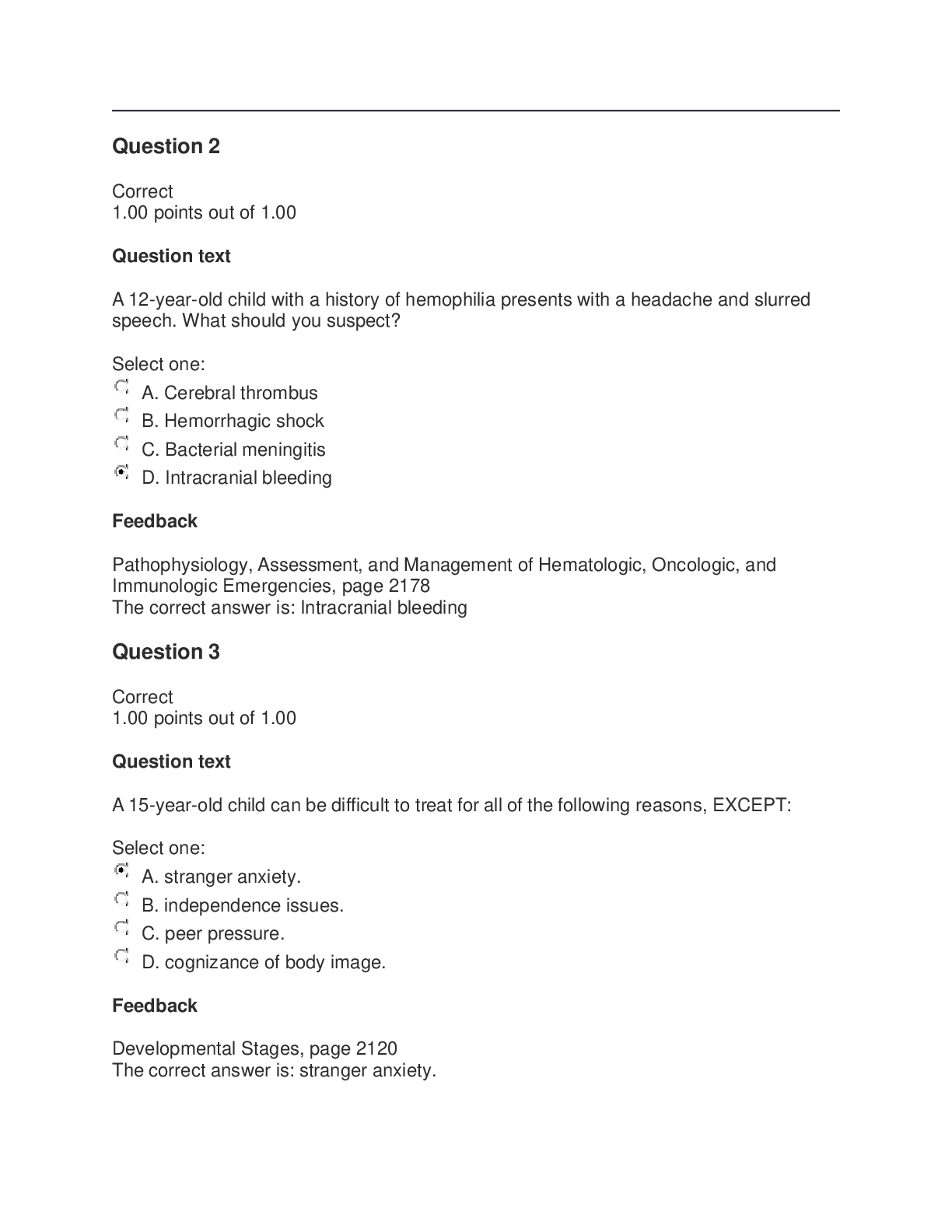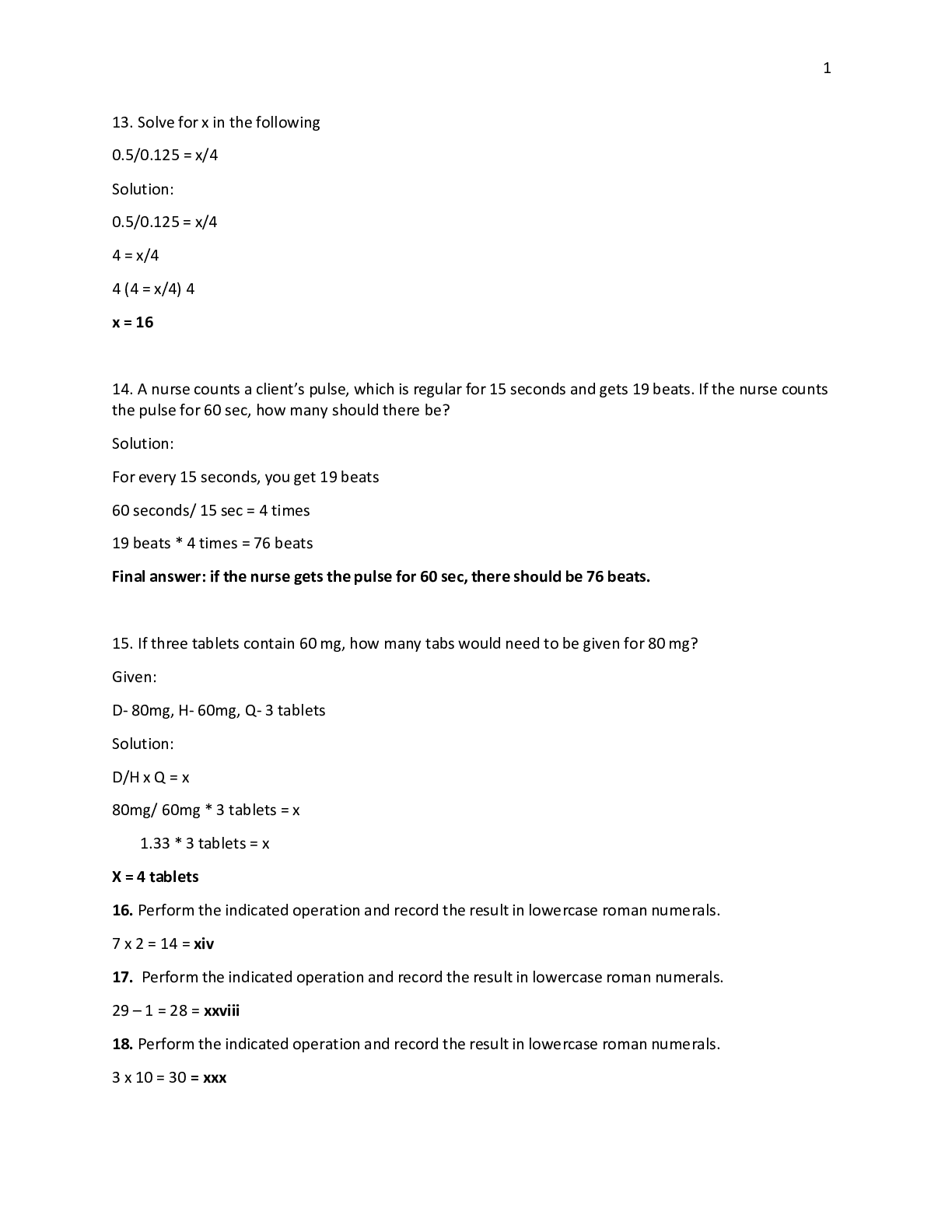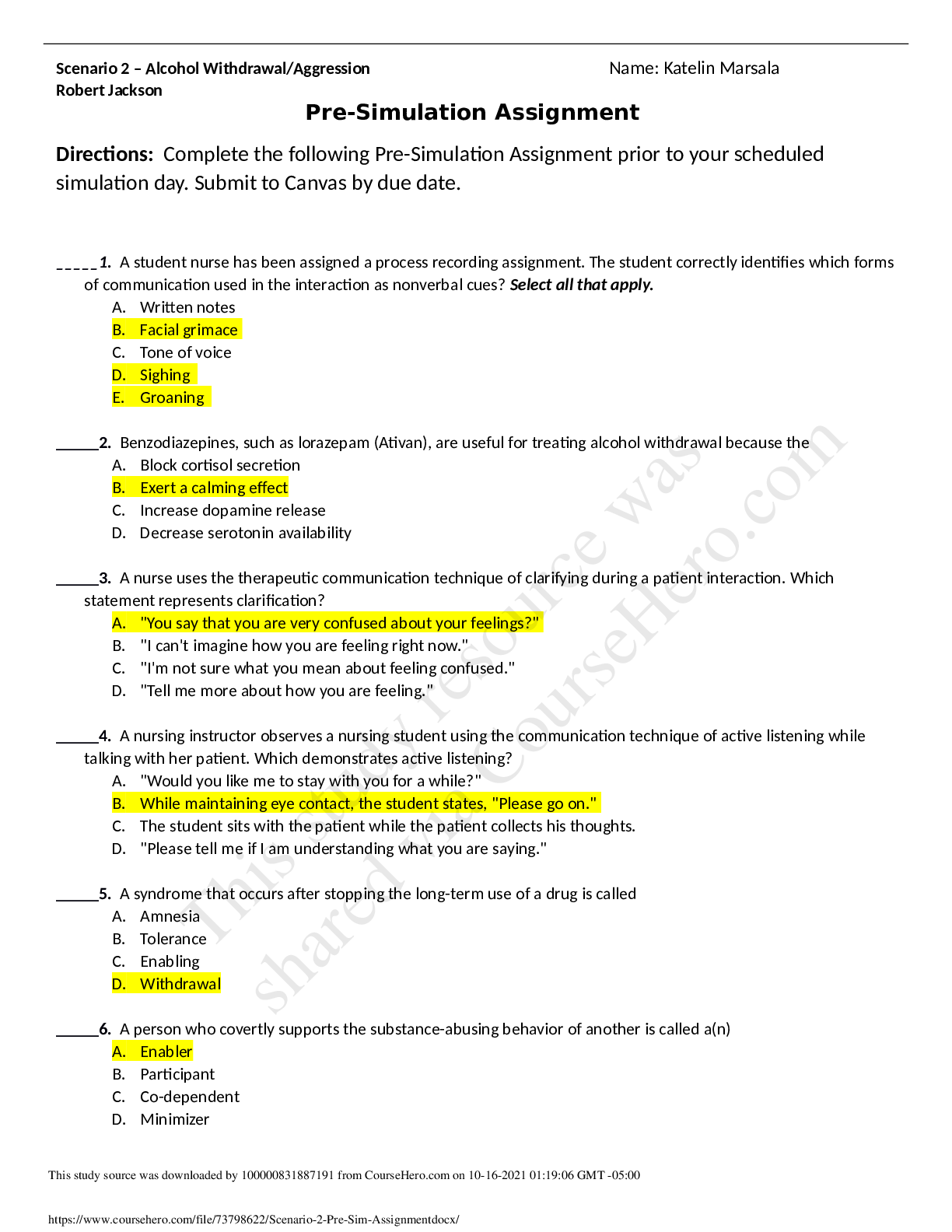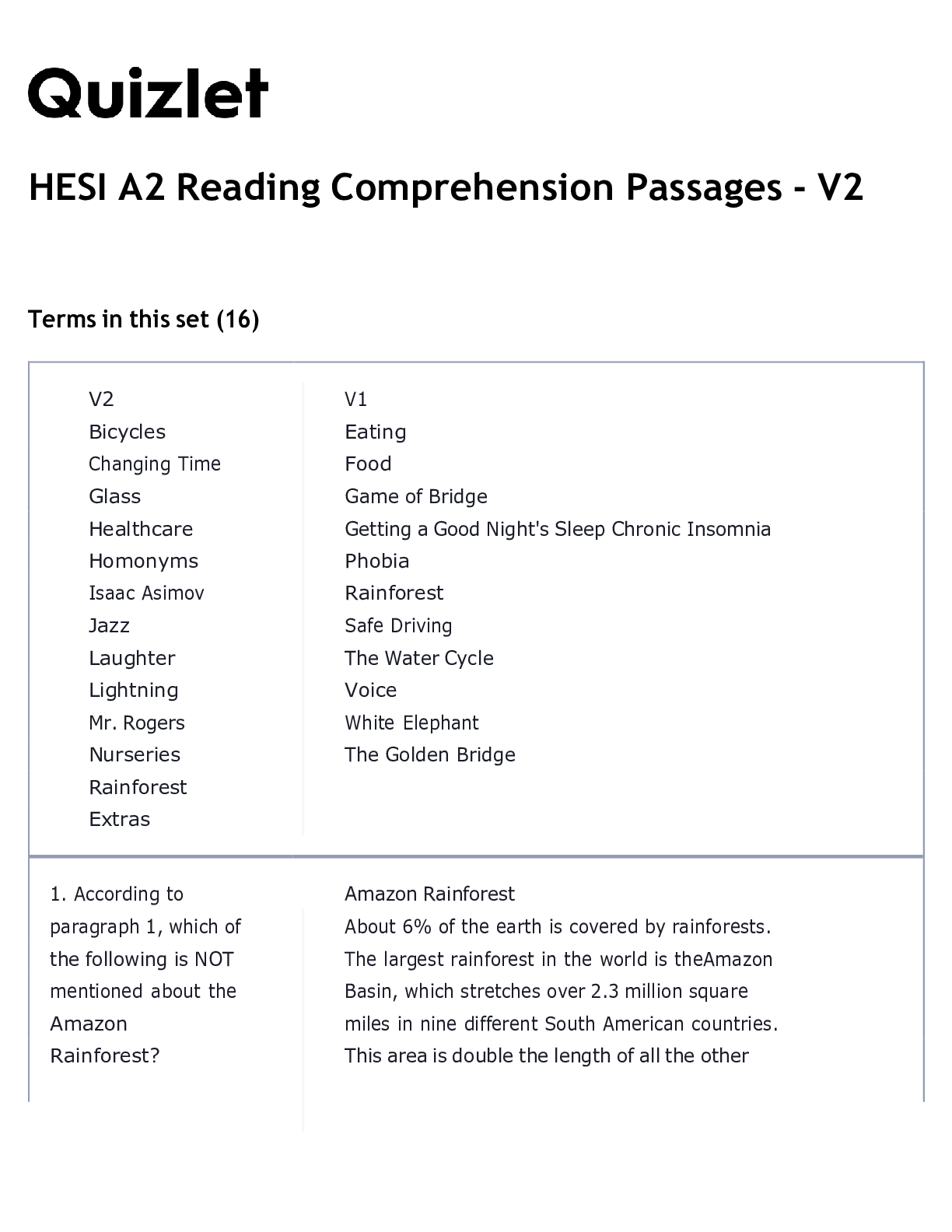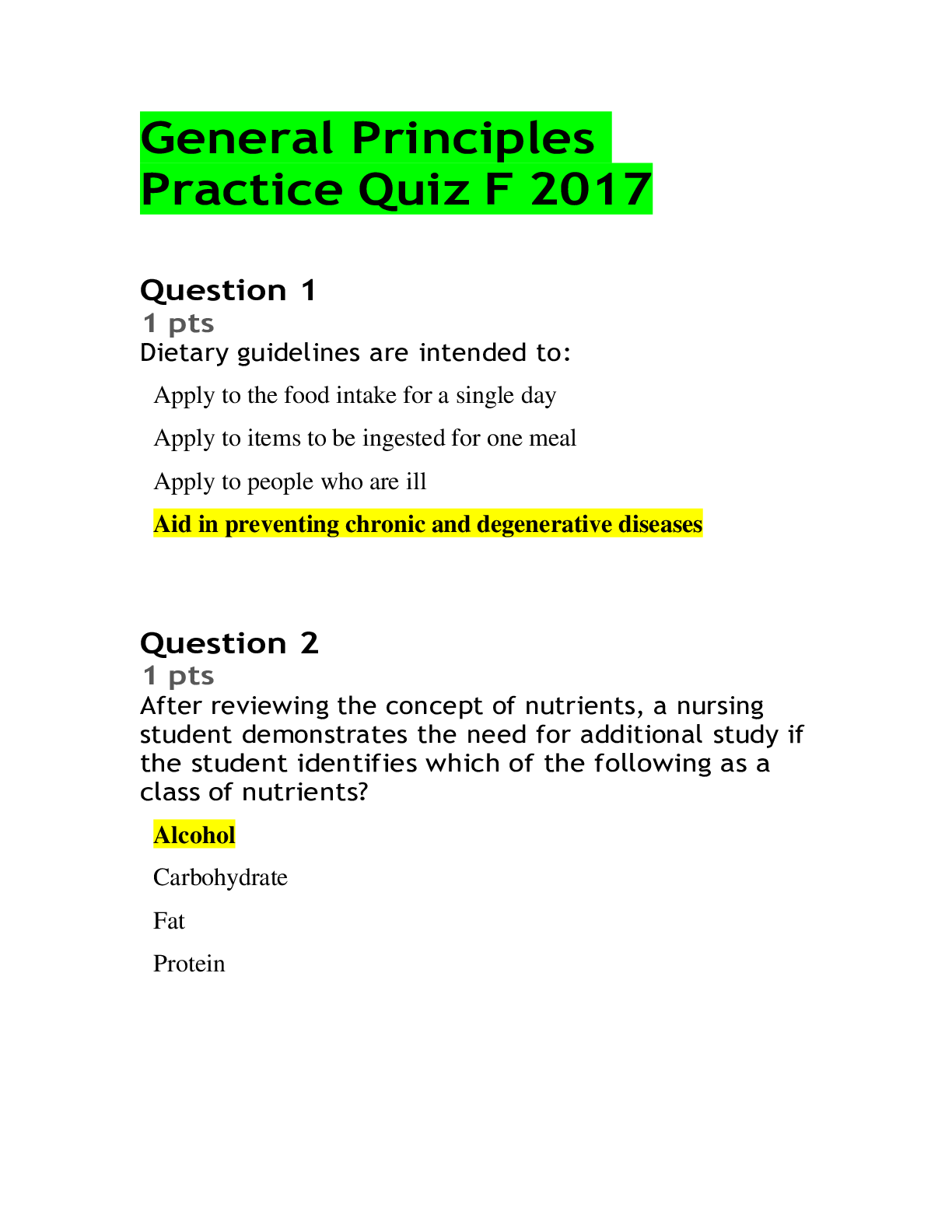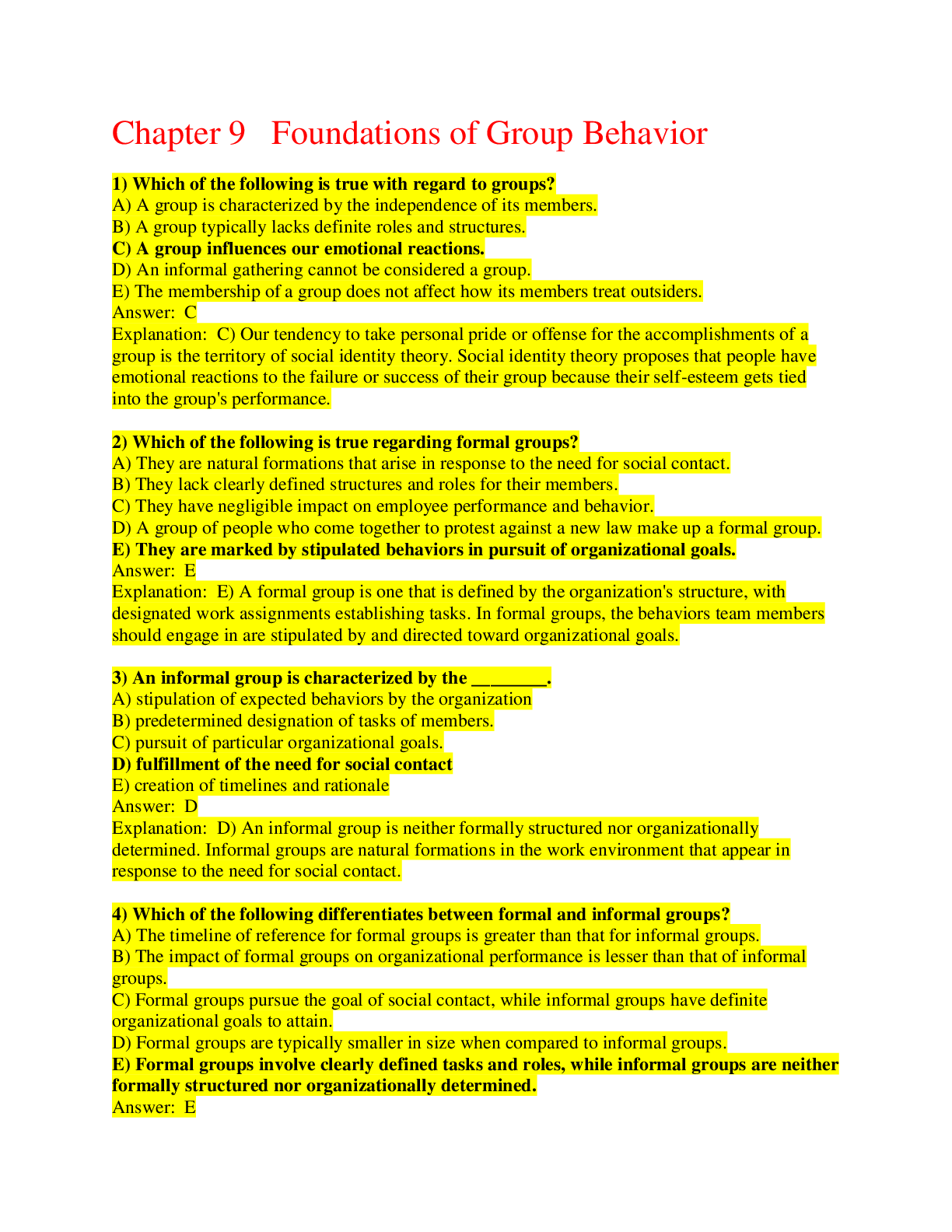*NURSING > QUESTIONS & ANSWERS > Test bank with 336 questions and correct answers to booste your grades (All)
Test bank with 336 questions and correct answers to booste your grades
Document Content and Description Below
1. The nurse is planning care for several children who were admitted during the shift. Daily weights should be the plan of care for the child who is receiving: a. Total parenteral nutrition(TPN) b... . Supplement oxygen c. Intravenous anti-ineffective d. Chest physiotherapy 2. The nurse is caring for a 4-year-old patient with a diagnosis of cystic fibrosis and pneumonia. The child is feeling better on the 3rd day of the hospitalization and “wants to play.” What would be the best choice of entertainment? a. Blowing bubbles b. Looking at picture books c. Watching videos d. Riding in a wagon ودالشمال4 3. A nurse is caring for an 8-year-old male with cystic fibrosis. Based on the nurse’s understanding of the disease. What nursing intervention should the nurse expect to perform? a. Restrict sodium and fluid intake b. Give antidiarrheal medications c. Discourage coughing after postural drainage d. Administer pancreatic enzymes with each meal 4. A nurse is caring for a child with a diagnosis of cystic fibrosis and pneumonia. The plan of care includes nebulizer treatment and chest physiotherapy. The nurse should perform chest physiotherapy: a. Continuously during the nebulizer treatment b. Prior to the nebulizer treatment c. After the nebulizer treatment d. Intermittently during the nebulizer treatment ودالشمال4 5. While caring for a patient with an ileostomy, the nurse would expect the ostomy to be located In Which Quadrant of the abdomen? a. Right lower b. Left lower c. Left upper d. Right upper 6. A patient has been assessed and found to have severe dysphagia and will need long-term nutritional support, which one of the following types of feeding would MOST likely to be beneficial for this patient? a. Gastrostomy b. Patenteral c. Nasogastric d. Nasoduodenal 7. A nurse is caring for a patient receiving total parenteral nutrition (TPN). The patient reports the sudden onset of feeling short of breath and anxious. The nurse hears crackles in bilateral lower ودالشمال4 lobes of the lungs and the patient’s O2 saturation is 90%on room air. The nurse must IMMEDIATELY: a. Turn off the TPN b. Notify the physician c. Asses the patient’s capillary blood glucose level d. Attempt to suction the patient’s airway 8. A nurse has just started total parenteral nutrition (TPN) as prescribed for a patient with severe dysphagia low prealbumin levels. In one to two hours, the nurse should anticipate assessing the patient’s: a. Blood glucose level b. Weight c. Liver d. Spo 2 9. The nurse is evaluating the patient with end stage chronic obstructive pulmonary disease (COPD).The patient has not ودالشمال4 achieved any of the goals in the plan of care. The spouse reports concerns about the patient’s mood and increased dependency .What action should the nurse take FIRST? a. Continue the care plan for 1more month b. Refer the patient to psychiatric services c. Collaborate with the patient and spouse to revise the care plan d. Revise the care plan based on the spouse’s input 10. A home care patient with chronic obstructive pulmonary disease (COPD)reports an upset stomach. The patient is taking theophylline(Theo-Dur) and triamcinoloneacetonide (Azmacort) The nurse should instruct the patient to take: a. Theo-dur an empty stomach b. Theo-dur and azmacortat the same time c. Theo-dur and azmacort12 hours apart d. Theo-dur milk or crackers 11. When giving post-operative discharge instructs a patient who had abdominal surgery, all of the following regarding wound healing are true EXCEPT: a. Bathing to soak abdomen is preferred ودالشمال4 b. Avoid tight belts and cloths with seams that may rub the wound c. Pain medication may affect ability to drive. d. Irregular bowel habits can be expected 12. A nurse giving post-operative discharge instructs a patient who had abdominal surgery, when teaching the patient about wound healing all of the following are the true EXCEPT: a. Wound may feel tightly or itchy as healing occurs b. Scabs promote infection of the new skin underneath them c. Numbness or a slight pulling sensation is normal d. Wound should not have any drainage 13. A 12-year-old child who has been diagnosed with insulin dependent mellitus (IDDM) since age3.Comes to the clinic for a routine visit. The patient has begun to self-manage care with parental supervision. The patient injects 28 units of NPH insulin every morning and 8units at bedtime. The patient checks blood sugar 4 times every day. The patient’s weight is stable and diet is unchanged. However, the patient reports several hypoglycemic reactions every week. The nurse knows the MOST likely cause is that: a. The patient is not eating the adequate number of calories reported b. The dosages of insulin may need to be decreased as the patient continues to grow c. There may be changes in exercise or stress levels or the beginning of a growth Spurt d. The patient may not be competent in techniques of drawing up and injecting insulin 14. A nurse visits a patient at home who does not understand how to take a newly prescribed medication. The prescription reads: 5 ml PO TID p.c. meals. The nurse explains to the patient that the correct way to take the medication is: a. 1 teaspoon by mouth, 3times a day, before meals b. 1 teaspoon by mouth, 3times a day, after meals c. 1 tablespoon by mouth, 3times a day, before meals d. 1 tablespoon by mouth, 3times a day, after meals 15. The nurse is caring for a patient who had major abdominal surgery under general anesthetic 4 hours ago. An appropriate goal for the patient includes: a. Having minimal fine crackles in the base of the lungs b. Using the incentive spirometry every 4 hours c. Expectorating minimal amount of secretions d. Performing Coughing Exercises every hour while awake 16. While caring for a child with aventriculoperitoneal shunt revision, the nurse find the patient lying with the head and feet flexed back. The nurse should call for help and prepare for a(n): a. Spinal tap b. Shunt culture c. Electrocardiogram d. Ventricular tap 17. During surgery requiring general anesthesia, the patient heart’s stops and a carotid pulse is not palpated. How many compressions per minute should be administered? a. 50 b. 60 c. 80 d. 100 18. When teaching a community class on cerebrovascular accidents (stroke), which of the following should participants of the class know at the completion of the class? a. Muscle and ligament damage is not reversible b. Expressive aphasia is resolved by voice rest c. There is a risk for mood disorders such as depression d. Liquids should be consumed at the same times as solids food 19. A community health care nurse visits a patient who had cerebrovascular accident. The patient is at risk for deficient volume due to voluntary reduction intake fluid intake to avoid the use of the bathroom. The nurse educates the patient on the importance of drinking fluids and maintaining hydration. Which of the following indicates the efficacy of the nursing intervention? a. Amber color urine b. Respiration of 35 c. Tachycardia d. Moist mucous membrane 20. A home health nurse is visiting a patient following a cerebrovascular accident (CVA). The patient is having trouble sleeping and is feeling sad. The patient’s spouse tells the nurse that the patient is not eating much and often cries when nooneis watching. Which of the following would be the nurse’s MOST likely intervention? a. Assess for changes in cognitive abilities b. Complete a depression index c. Strengthen family coping methods d. Screen for pain .....................................................................CONTINUED.................................................................................... [Show More]
Last updated: 2 years ago
Preview 1 out of 340 pages
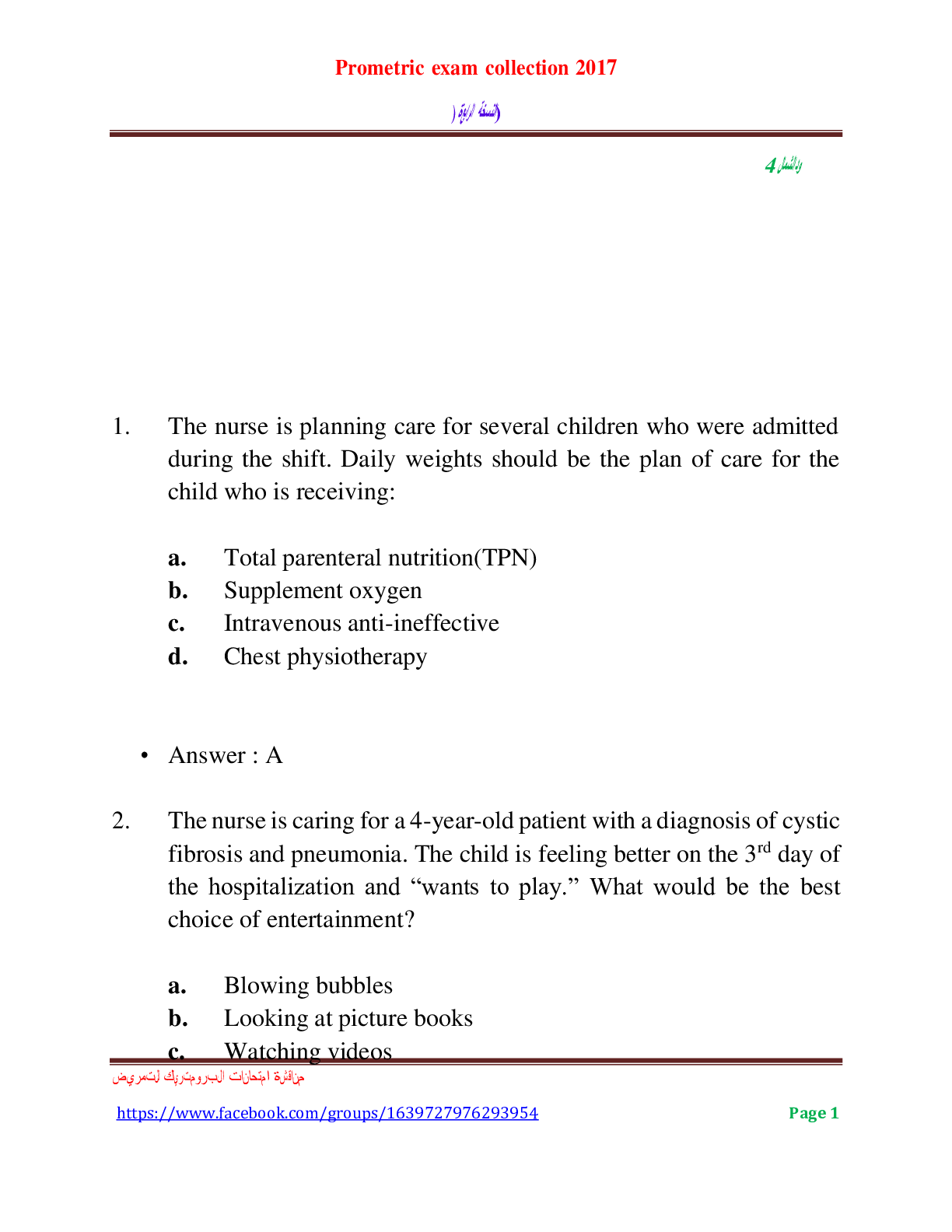
Buy this document to get the full access instantly
Instant Download Access after purchase
Buy NowInstant download
We Accept:

Reviews( 0 )
$15.00
Can't find what you want? Try our AI powered Search
Document information
Connected school, study & course
About the document
Uploaded On
Apr 15, 2021
Number of pages
340
Written in
Additional information
This document has been written for:
Uploaded
Apr 15, 2021
Downloads
0
Views
74


.png)


